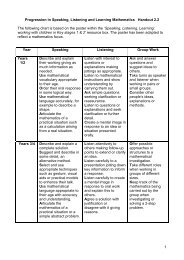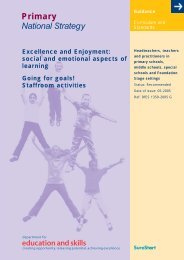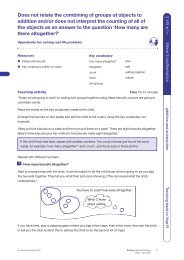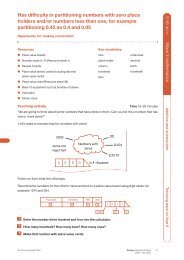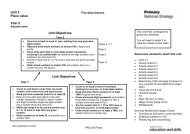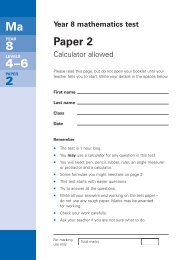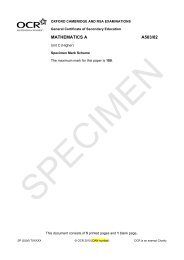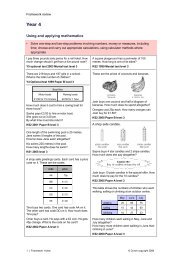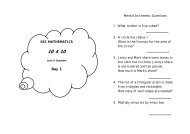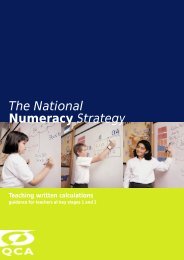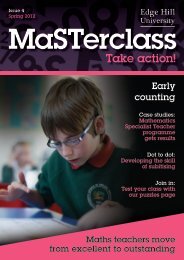Year 3 Block A: - Suffolk Learning
Year 3 Block A: - Suffolk Learning
Year 3 Block A: - Suffolk Learning
Create successful ePaper yourself
Turn your PDF publications into a flip-book with our unique Google optimized e-Paper software.
3 of 20 The National Strategies ⏐ Primary<strong>Year</strong> 3 <strong>Block</strong> A: Counting, partitioning and calculatingcount on/back, add, subtract, multiply, times, divide, share, group, sum, total, difference, plus,minuspound ( £ ), penny/pence (p), note, coin, units of measurement and their abbreviationsBuilding on previous learningCheck that children can already:• talk about their methods and solutions to one-step problems, identifying and recording thenumber sentences involved• read, write, partition and order two-digit numbers, explaining what each digit represents• recall all addition and subtraction facts for each number to at least 10, all pairs with totals to20 and all pairs of multiples of 10 with totals up to 100• add or subtract mentally pairs of one-digit numbers• recall multiplication and division facts for the 2, 5 and 10 times-tables00543-2008DOM-EN-11 © Crown copyright 2009
4 of 20 The National Strategies ⏐ Primary<strong>Year</strong> 3 <strong>Block</strong> A: Counting, partitioning and calculating<strong>Year</strong> 3, <strong>Block</strong> A: Counting, partitioning and calculatingUnit 1<strong>Learning</strong> overviewContained in this learning overview are suggested assessment opportunities linked to theassessment focuses within the Assessing Pupils’ Progress (APP) guidelines. As you plan yourteaching for this unit, draw on both these suggestions and alternative methods to help you togather evidence of attainment or to identify barriers to progress that will inform your planning tomeet the needs of particular groups of children. When you make a periodic assessment ofchildren’s learning, this accumulating evidence will help you to determine the level at which theyare working. To gather evidence related to the three Ma1 assessment focuses (problem solving,reasoning and communicating) it is important to give children space and time to develop theirown approaches and strategies throughout the mathematics curriculum, as well as through theapplication of skills across the curriculum.In this unit the illustrated assessment focuses are:• Ma1, Reasoning• Ma2, Numbers and the number system• Ma2, Solving numerical problems.Children read and write whole numbers to at least 1000 in figures and words. They identify theposition of these numbers on a number line, using their understanding of place value to locatethe hundreds and tens numbers and to explain their relationships. They know the ordinalnumbers to at least 100 and use them in practical contexts, such as describing the position of ateam in a league table or the order of quantities or numbers according to size.Children count on and back in steps of 1, 2, 3, 4, 5, 6 and 10 from zero and then from anygiven number. They use these sequences to count on or back in steps of 10, 20, 30, 40, 50, 60or 100. They use their counting skills to answer questions such as:If I keep subtracting 6 from 49, what is the smallest number I will get?They recognise the relationships between counting in: 2s and 4s; 3s and 6s; 5s and 10s.Children count a large collection of objects by grouping them, for example, into fives, tens ortwenties. They recognise how this helps them to find the total number of objects systematicallyand accurately and gives a method to use to check the result.Children partition two- and three-digit numbers and use their knowledge of place value tocompare and order numbers with up to three digits. They use the vocabulary and symbolsassociated with comparing and ordering of numbers. They compare two three-digit numbers,such as 456 and 465, and read and record that 465 > 456 or 456 < 465. They give reasons fortheir choice. Children answer questions such as: What multiples of 10 lie between 256 and 283?In order to identify missing numbers, they pose questions of their own such as:Does it lie between 50 and 80?If I count in threes from zero, will it be in my sequence of numbers?00543-2008DOM-EN-11 © Crown copyright 2009
5 of 20 The National Strategies ⏐ Primary<strong>Year</strong> 3 <strong>Block</strong> A: Counting, partitioning and calculatingAssessment focus: Ma2, Numbers and the number systemAs they become familiar with two- and three-digit numbers, look for those children who canexplain the place value of each digit. Look for children who use different models of the numbersystem to represent numbers, for example, using arrow cards to represent numbers or locatingnumbers quickly on a number line. Look for children who, when given a number, know themultiples of ten between which it lies on the number line and which multiple is nearest. Look forchildren who know whether a two-digit number is closer to 0 or to 100.Children say and record numbers that are 1, 10 or 100 more than or less than any number to1000. They use their knowledge and counting strategies to add or subtract multiples of 10 or100. For example, they work out that 167 minus 30 is 137 by counting back in tens from 167(157, 147, 137), keeping track of the count by recording jumps on a number line. They answerone- and two-step word problems, such as: If you add two 20p coins to £1.35, how muchmoney is that altogether? They use notes and diagrams, including number lines, to supportand explain their methods.Children locate and position multiples of 10 or 100 on a number line and recognise the relativeposition of other numbers. They use their knowledge of place value to establish that 374 iscloser to 400 than 300 and closer to 370 than 380. They add or subtract mentally one-digitnumbers to or from two-digit numbers, bridging through a multiple of 10 where appropriate.For example, they calculate 72 – 8 by subtracting 2 to give 70 and then subtracting theremaining 6, using a number line to record the steps if necessary. Children use counting onwhen adding 5 to 36 or counting back when subtracting 5 from 39.Assessment focus: Ma1, ReasoningLook for children who identify patterns in results, for example:Look for children who use the patterns they identify to generate further calculations. As childrenexplain their results, identify the reasoning they use to decide if a particular example will appearlater in their list of calculations. Using the pattern above, for example, look for children who canpredict and explain which addition will give the first total greater than 50 or greater than 100.Children solve problems involving counting such as:How many 5p coins would be needed to pay for an item costing 37p?How many 3p and 4p stamps might we use for a 19p letter? And a 29p letter?They also solve number puzzles, such as:Complete each of these number sentences in as many different ways as possible:5 + 8 = 2 – 7 = .Children organise their written responses to problems and puzzles in a systematic way, forexample, in a list or table. This helps them to recognise and continue patterns, and to reasonthat all solutions have been found. They talk about their methods and compare solutions. Theyexplain how they organised their work to find all possibilities.00543-2008DOM-EN-11 © Crown copyright 2009
6 of 20 The National Strategies ⏐ Primary<strong>Year</strong> 3 <strong>Block</strong> A: Counting, partitioning and calculatingAssessment focus: Ma2, Solving numerical problemsLook for children who can choose the appropriate operation when solving problems. Forexample, in a problem involving several toy railway carriages of the same length, they might userepeated addition to find the total length of a ‘train’ of carriages placed end to end.00543-2008DOM-EN-11 © Crown copyright 2009
7 of 20 The National Strategies ⏐ Primary<strong>Year</strong> 3 <strong>Block</strong> A: Counting, partitioning and calculatingObjectivesChildren's learning outcomes are emphasised• Describe and explain methods, choices andsolutions to puzzles and problems, orally and inwriting, using pictures and diagramsI can explain how I solve problems• Read, write and order whole numbers to at least1000 and position them on a number line; counton from and back to zero in single-digit steps ormultiples of 10I can read and write numbers to 1000 and putthem in order• Partition three-digit numbers into multiples of100, 10 and 1 in different waysI can split a number into hundreds, tens andonesI can explain how the digits in a number changewhen I count in 10s or 100s• Derive and recall all addition and subtractionfacts for each number to 20, sums anddifferences of multiples of 10 and number pairsthat total 100I know the sum and difference of any pair ofnumbers to 20I can add and subtract multiples of 10 or 100 inmy headAssessment for <strong>Learning</strong>Tell me how you solved this problem. Why did youdecide to subtract these numbers?Did you do that calculation in your head? Tell mehow you did it. Show me how to do that calculationon an empty number line.Suppose the problem had these numbers. Wouldthat change the way you would solve the problem?Here is a number: 472. Read it to me. Writeanother three-digit number and read it to me. Is itbigger than or smaller than 472?Draw an empty number line and mark the numbers456, 465 and 516 on it.Tell me where to put these numbers on thenumber line: 581, 418, 560, 509 and 495. How doyou find the smallest number/the largest number?What clues do you use?Here are some ways of partitioning 346.346 = 300 + 46346 = 300 + 40 + 6346 = 300 + 30 + 16346 = 200 + 120 + 26Write four more ways of partitioning 346.A number is partitioned like this: 200 + 50 + 13.What is the number? Show me how to partition it inother ways.How could you partition 408? Show me anotherway to do it.Use these digit cards. Make the number 346 forme. What does the 3 represent? And the 4?[Remove the 6.] What number do you have now?What does the 3 represent now? And the 4?Look at this number sentence: + = 19. Whatcould the two missing numbers be? What else?Can you tell me all the pairs of numbers that make19? How do you know you have got them all?What is 13 – 8? What other subtractions make 5?Add or subtract these numbers. Tell me how youdid it.30 + 80 70 – 50800 + 500 900 – 40038 + 40 80 – 2700543-2008DOM-EN-11 © Crown copyright 2009
8 of 20 The National Strategies ⏐ Primary<strong>Year</strong> 3 <strong>Block</strong> A: Counting, partitioning and calculating• Add or subtract mentally combinations of onedigitand two-digit numbersI can add and subtract one-digit and two-digitnumbers in my head(e.g. 62 + 7, 7 + 45, 48 – 6, 60 – 8)• Explain a process or present information,ensuring items are clearly sequenced, relevantdetails are included and accounts endedeffectivelyI can explain how I add and subtract numbers inmy headI can explain how to put three-digit numbers inorderLook at this calculation: 5 + 8 = . Write adigit in each box so that the calculation is correct.How else can you do it? What patterns do younotice?Repeat with 2 – 7 = .What is the largest multiple of 10 you can add to38 if your answer must be smaller than 100?Explain the relationship between adding 3 to 4 andadding 30 to 40 and 300 to 400.Explain how you can use a number line to add 37to 56. Now show me how you could use a 100-square to add 37 to 56. Repeat for subtraction.Explain how you would put this set of numbers inorder: 162, 216, 126, 621, 26100543-2008DOM-EN-11 © Crown copyright 2009
9 of 20 The National Strategies ⏐ Primary<strong>Year</strong> 3 <strong>Block</strong> A: Counting, partitioning and calculating<strong>Year</strong> 3 <strong>Block</strong> A: Counting, partitioning and calculatingUnit 2<strong>Learning</strong> overviewContained in this learning overview are suggested assessment opportunities linked to theassessment focuses within the Assessing Pupils’ Progress (APP) guidelines. As you plan yourteaching for this unit, draw on both these suggestions and alternative methods to help you togather evidence of attainment or to identify barriers to progress that will inform your planning tomeet the needs of particular groups of children. When you make a periodic assessment ofchildren’s learning, this accumulating evidence will help you to determine the level at which theyare working. To gather evidence related to the three Ma1 assessment focuses (problem solving,reasoning and communicating) it is important to give children space and time to develop theirown approaches and strategies throughout the mathematics curriculum, as well as through theapplication of skills across the curriculum.In this unit the illustrated assessment focuses are:• Ma1, Communicating• Ma2, Numbers and the number system• Ma2, Operations and relationships between themChildren continue to count on or back from any number. They know what each digit in a threedigitnumber is worth and recognise and explain the effect on the digits as they count in 10s or100s and the impact of crossing boundaries when moving between 10s and 100s, and between100s and 1000s. Children use their knowledge of the relationship between numbers on anumber line to round any two-digit number to the nearest 10 and any three-digit number to thenearest 100.Children use the vocabulary of estimation and approximation. They estimate the number ofitems in a container with up to 100 items, for example, saying that the number of items is about35 or that there are between 30 and 40. They use rounding to work out, for example, that to buyfour 22p oranges the cost will be a bit more than 80p and count up in 20s and 2s to get theanswer.Children recognise the significance of each digit when adding and subtracting. They continueto add and subtract multiples of 10 and 100 and extend this to adding and subtracting nearmultiples.They work out, for example, 632 + 200 and 632 – 200, and then use their answers tofind 632 + 199 and 632 – 201, making notes or identifying the steps on an empty number line.Children derive sequences in calculations such as 32 – 1 = 31, 32 – 2 = 30, 32 – 3 = 29 … andcorresponding sequences such as 320 – 10 = 310, 320 – 20 = 300, 320 – 30 = 290 … Theydescribe the patterns they observe and apply them to other sequences.Children understand that when a one- or two digit-number is multiplied by 10 the digits moveone place to the left and that doing this twice is equivalent to multiplying by 100. Children beginto multiply a one-digit number by a multiple of 10, for example working out 7 × 50 by finding7 × 5 then multiplying the answer by 10. They use their knowledge of inverse operations to workout, for example, 350 ÷ 50 and 350 ÷ 7.00543-2008DOM-EN-11 © Crown copyright 2009
10 of 20 The National Strategies ⏐ Primary<strong>Year</strong> 3 <strong>Block</strong> A: Counting, partitioning and calculatingAssessment focus: Ma2, Numbers and the number systemLook for evidence of children’s understanding of place value. Look for children who know whichdigit will change when they add or subtract 10 or 100. Look for evidence of children who canmultiply whole numbers by 10 and divide numbers by 10 where the answer is a whole number.Look for children who map a set of numbers onto numbers in a corresponding set, using therelationship ‘× 10 =’ or ‘÷ 10 =’. Look out for children who begin to use this with amounts ofmoney, for example, children who recognise that 45p maps onto £4.50, using the relationship‘× 10 = ’.Children partition two-digit numbers in different ways; for example, they recognise that 75 canbe partitioned into 70 + 5 or 60 + 15. They use partitioning flexibly to support calculationstrategies, for example, partitioning 75 into 60 + 15 in order to subtract 28 by subtracting 20 from60 and 8 from 15. They solve problems involving partitioning, such as:If two people share £38 and one person gets £10 more than the other, how much do theyeach get?They use diagrams to help them solve these problems and record their solutions.Children understand the term difference. They appreciate that Find the difference between 38and 52 is equivalent to the question: How much greater is 52 than 38? and relate these to thesubtraction 52 – 38. They find the difference by counting up from 38 to 52. Children usepartitioning to add or subtract mentally one- and two-digit numbers. For example, they calculate37 + 26 by using 37 + 20 + 6 and 37 – 26 by working out 37 – 20 – 6, recording the steps on anumber line. Children begin to check their addition and subtraction with a calculation that usesthe inverse operation. They know that subtracting 18 from 34 to get 16 can be checked byadding 18 to 16.Assessment focus: Ma2, Operations and relationships between themLook for evidence of children using inverse operations. Look for children who find missingnumbers in examples such as 36 + = 56. Look for children who, given three numbers such as14, 24 and 10, create a set of related addition and subtraction sentences or, given 14, 10 and140, create a set of related multiplications and divisions. Look for children who solve problemssuch as: ‘I think of a number, double it and add 5. The answer is 47. What number did I thinkof?’ Look out for children who are beginning to understand the role of the equals sign, ‘=’, innumber sentences with missing numbers, such as 6 × 10 = 75 – .Children solve puzzles and problems that involve all four operations. They use theirknowledge of multiplication and division to find the cost of boxes of six items where each itemcosts 40p or the number of boxes of four items that can be filled from 30 items. They developstrategies to solve ‘think of a number’ problems that involve halving and doubling. They explorenumbers, looking for pairs that total 30 and have a difference of 12, by listing possible pairs andtesting to see if the second criterion holds. Children discuss and explain their methods orallyand begin to record, using pictures or diagrams. They follow the explanations of others, forexample, how they solved 'think of a number' problems. They compare different approaches andsuggest possible modifications.00543-2008DOM-EN-11 © Crown copyright 2009
11 of 20 The National Strategies ⏐ Primary<strong>Year</strong> 3 <strong>Block</strong> A: Counting, partitioning and calculatingAssessment focus: Ma1, CommunicatingLook for evidence of the range of language children use and respond to when they are talkingabout numbers and operations. Look out for children who respond to and use terms such assign, plus, minus, equals, number sentence, add, subtract, find the difference, multiply, divide,calculate and calculation when discussing operations. Look for evidence of the symbols thatchildren use and interpret, for example, +, –, ×, ÷ and =. Look for children who are interpreting consistently.00543-2008DOM-EN-11 © Crown copyright 2009
12 of 20 The National Strategies ⏐ Primary<strong>Year</strong> 3 <strong>Block</strong> A: Counting, partitioning and calculatingObjectivesChildren's learning outcomes are emphasised• Describe and explain methods, choices andsolutions to puzzles and problems, orally and inwriting, using pictures and diagramsI can explain how I solve problems• Partition three-digit numbers into multiples of100, 10 and 1 in different waysI can split a number into hundreds, tens andonesI can explain how the digits in a number changewhen I count in 10s or 100s• Round two-digit or three-digit numbers to thenearest 10 or 100 and give estimates for theirsums and differencesI can round numbers to the nearest 10 or 100and estimate a sum or differenceAssessment for <strong>Learning</strong>Tell me how you solved this problem. Did youmake any notes or drawings to help you? Can youdescribe them to me?Show me how to solve this problem, usingpractical objects. What is the cost of 12 stamps at5p each?Draw me a picture to show how to solve theproblem.Why is this a good mental method for adding 19?What is the difference between adding 19 andsubtracting 19, using this method? Show me whythis is, using a 100-square.Start at 93 and count back in tens. What will be thesmallest number that you reach on a 100-square?Will 54 be one of the numbers you would say?Why not?What do you look for when finding a number 100less than (or 100 more than) a given number?Count on in tens from 312. Which digits change?Why does the ones (units) digit not change? Whendoes the hundreds digit change, and whathappens to the tens digit in this case? Whathappens when you count back?If we count in 100s from 1, what is the pattern? Isthis the same or different when we count from 11or 111?Why does 76 become 80 when it is rounded to thenearest 10? Why does 249 become 200 whenrounded to the nearest 100?Round 249, 243 and 245 to the nearest 10. Explainwhy you decided to round 249 and 245 up to 250,and 243 down to 240.The answer to 44 + 38 is less than 100. Give me abetter estimate. How did you do it?Why is 38 + 24 approximately 60? Why is 51 – 27approximately 20?00543-2008DOM-EN-11 © Crown copyright 2009
13 of 20 The National Strategies ⏐ Primary<strong>Year</strong> 3 <strong>Block</strong> A: Counting, partitioning and calculating• Derive and recall all addition and subtractionfacts for each number to 20, sums anddifferences of multiples of 10 and number pairsthat total 100I know the sum and difference of any pair ofnumbers to 20I can add and subtract multiples of 10 or 100 inmy headI know number pairs that sum to 100• Add or subtract mentally combinations of onedigitand two-digit numbersI can add or subtract one-digit and two-digitnumbers in my head(e.g. 62 + 7, 7 + 45, 48 – 6, 60 – 8)• Multiply one-digit and two-digit numbers by 10or 100, and describe the effectI can multiply by 10 or 100 and say whathappens to the number I multiply• Derive and recall multiplication facts for the2, 3, 4, 5, 6 and 10 times-tables and thecorresponding division facts; recognisemultiples of 2, 5 or 10 up to 1000I know my tables for 2, 3, 4, 5, 6 and 10• Follow up others’ points and show whether theyagree or disagree in a whole-class discussionIn a discussion I can share my views withothers in the class and follow up their pointsWhat is 3 + 4, 30 + 40 and 300 + 400?What is 8 – 5, 80 – 50 and 800 – 500? How do youknow?Two numbers add up to 20. They have a differenceof 2. What are the numbers?What must you add to 62p to make £1?I cut 53cm off 1 metre of string. How long is thepiece that is left?What is 46 + 8? Explain how you did it.How would you add 18 to 46?What is 73 – 7? Explain how you did it.How would you subtract 17 from 73?Think of two numbers that have a difference of 9.Write a number sentence to show this. Now findand record some more pairs of numbers with adifference of 9.What is 58 + 30? What is 58 + 29? How do youknow? What is 58 – 30? What is 58 – 29? How didyou work these out? Show me on an emptynumber line.Multiply 4 by 10. Multiply the answer by 10. Whathas happened to the value of the digit 4? Can youexplain what happens to the 4 when we multiply 4by 100?What number is 10 times more than 70 tens? Whatis 10 times bigger than 23?Count on in fours from zero. Now count back tozero. This time, count on seven fours from zero.Show me seven hops of four from zero on thenumber line. How can you work out the 4 timestablefrom the 2 times-table? The 6 times-tablefrom the 3 times-table?What is the relationship between 4 × 7 = 28,6 × 7 = 42 and 10 × 7 = 70?Is this calculation correct? John thinks that it iswrong. Do you agree or disagree? Why do youthink so?Mary has just told us how she subtracted 39 from76. Use Mary's method to subtract 59 from 92.What diagram did you draw to help you to solvethe problem? Did anyone use a different diagram?00543-2008DOM-EN-11 © Crown copyright 2009
14 of 20 The National Strategies ⏐ Primary<strong>Year</strong> 3 <strong>Block</strong> A: Counting, partitioning and calculating<strong>Year</strong> 3 <strong>Block</strong> A: Counting, partitioning and calculatingUnit 3<strong>Learning</strong> overviewContained in this learning overview are suggested assessment opportunities linked to theassessment focuses within the Assessing Pupils’ Progress (APP) guidelines. As you plan yourteaching for this unit, draw on both these suggestions and alternative methods to help you togather evidence of attainment or to identify barriers to progress that will inform your planning tomeet the needs of particular groups of children. When you make a periodic assessment ofchildren’s learning, this accumulating evidence will help you to determine the level at which theyare working. To gather evidence related to the three Ma1 assessment focuses (problem solving,reasoning and communicating) it is important to give children space and time to develop theirown approaches and strategies throughout the mathematics curriculum, as well as through theapplication of skills across the curriculum.In this unit the illustrated assessment focuses are:• Ma1, Reasoning• Ma2, Numbers and the number system• Ma2, Solving numerical problems• Ma2, Mental methods• Ma2, Written methodsChildren consolidate their counting on and back in steps of 2, 3, 4, 5, 6 and 10. They recognisewhen the numbers in a counting sequence are odd or even. For example, counting in steps of 4from 3 will generate odd numbers only, while when counting in steps of 3 from 4 the numbersalternate between odd and even. Children count in steps of two-digit numbers such as 12s, from3, using a 10 and 2 count, to generate 3, 13, 15, 25, 27, 37, 39, 49, 51, … alternately whisperingquietly and shouting aloud the numbers involved.Assessment opportunity: Ma2, Numbers and the number systemLook for evidence of children using their knowledge of odd and even numbers to explain howthey know, for example, if 21 is in the sequence that starts at 3 and goes up in steps of 2. Lookout for children who are able to use a given rule, for example, ‘find half the last number then add10’ to continue the sequence:36 28 24 Children solve problems and puzzles involving all four operations. They identify relevantinformation and select the appropriate operations in order to solve word problems such as:There are 12 stamps in a sheet. Each stamp costs 28p. I buy a quarter of the sheet. Howmany stamps is this?I pour out 180 ml and then 270 ml from a one-litre bottle of squash. How much is left?00543-2008DOM-EN-11 © Crown copyright 2009
15 of 20 The National Strategies ⏐ Primary<strong>Year</strong> 3 <strong>Block</strong> A: Counting, partitioning and calculatingAssessment opportunity: Ma2, Solving numerical problemsAs children solve word problems, notice how they interpret the language of the problem toidentify the steps that they need to take. Look for evidence of children being able to identify andcomplete both steps in a problem that involves addition and subtraction or multiplication andanother operation.Children use counting strategies and partitioning to add and subtract combinations of one- andtwo-digit numbers. They add two-digit numbers by partitioning one or both of the numbers. Forexample, they work out 58 + 74 by partitioning 58 into 50 and 8 then adding 50 and 8 to 74.Children use a similar strategy for subtraction, for example, working out 94 – 58 or 294 – 58 bypartitioning the 58 and subtracting 50, then 8. They use counting-up strategies whereappropriate, as in 124 – 68 where they count up from 68 to 70, to 100, to 124, recording andadding the steps 2, 30 and 24. Children use a number line to note the steps and to explain howthey did the calculation. Children also subtract by counting on from the smaller to the largernumber, in their heads, when the difference is small, as in 305 – 297, making notes to supportcalculation.Assessment opportunity: Ma2, Mental methodsAs they add and subtract two-digit numbers mentally, look out for children who can explain howthey are solving the calculations. In particular, look for evidence of children making their owndecisions about whether to partition numbers or to count up.Children develop their use of the empty number line to support their calculations. They begin torecord vertically addition and subtraction calculations that cannot be easily done mentally.They partition one of the numbers and add or subtract the units, tens and hundreds separately:76+47267-149Children recognise the relationship between the vertical presentation and the steps on thenumber line. They begin to use an expanded layout that underpins the standard written method.For example, for 76 47 and 83 48 children use:00543-2008DOM-EN-11 © Crown copyright 2009
16 of 20 The National Strategies ⏐ Primary<strong>Year</strong> 3 <strong>Block</strong> A: Counting, partitioning and calculatingAssessment opportunity: Ma2, Written methodsAs children explain their written methods for adding and subtracting three-digit numbers, look forchildren who have an efficient method for examples that involve bridging 10 or 100 as well asexamples that do not.Children round two-digit and three-digit numbers to the nearest 10 and 100 and use this to giveapproximate answers to addition and subtraction calculations. For example, they recognise thatthe answer to 247 + 76 will be just less than 250 + 80 or 330, and 183 – 48 is about 180 – 50 or130. They understand that finding an approximate answer is a useful strategy for checking acalculation.Assessment opportunity: Ma2, Numbers and the number systemLook out for evidence of children using a number line to demonstrate how they are makingdecisions whether to round numbers up or down. Look out for children who can order numbersup to 100 and then 1000 and justify their answers through an understanding of place value.Children begin to work systematically, using lists or tables to organise their solutions toproblems such as:A farmer has cows and chickens on the farm. Altogether the animals have 24 legs. Howmany cows and chickens could there be on the farm?Using problems such as these gives the opportunity to assess children’s ability to communicatetheir mathematics and, in particular, to show how they are looking to develop organisedapproaches to recording their work.Children use their understanding of place value to support multiplication and division involvingmultiples of 10 to answer questions such as:Three pencils cost 90p altogether. How much does each pencil cost?Rani picks up seven 50 g weights. How much do these weigh altogether?Sam is making cards. Each card takes 20 minutes. He starts at 4:30 and makes four cards.What time does he finish?Children begin to use partitioning to multiply and divide two-digit numbers. For example, theycalculate 24 × 4 by partitioning 24 into 20 and 4 and working out 20 × 4 4 × 4, and 96 ÷ 3 bypartitioning 96 into 90 and 6 and dividing each part by 3 to get the answer 32. They identifyremainders in related calculations such as 95 ÷ 3, and begin to round the remainder up or downwhen the context demands it. For example, if cars can each transport up to 4 people, they workout that 12 people would need 3 cars but 13 people require 4 cars.Children solve problems such as:Use three of the digits 2, 3, 4, 5 and 6, to create multiplication calculations (e.g. 34 × 6).What products can you make? What is the largest/smallest product?They work in pairs or groups, with all children in the group contributing to decisions about themethods they use, whether they will use resources and how they will record their work.00543-2008DOM-EN-11 © Crown copyright 2009
17 of 20 The National Strategies ⏐ Primary<strong>Year</strong> 3 <strong>Block</strong> A: Counting, partitioning and calculatingAssessment opportunity: Ma1, ReasoningLook for evidence of children explaining their thinking and for children who are beginning tomake general statements. For example, when they are investigating where to place each ofthree digits in a TU × U multiplication to achieve the greatest product, look for children who areable to make a general statement about where the largest, middle and smallest digits should go.00543-2008DOM-EN-11 © Crown copyright 2009
18 of 20 The National Strategies ⏐ Primary<strong>Year</strong> 3 <strong>Block</strong> A: Counting, partitioning and calculatingObjectivesChildren's learning outcomes are emphasised• Solve one-step and two-step problems involvingnumbers, money or measures, including time,choosing and carrying out appropriatecalculationsI can solve a problem by writing down whatcalculation I should do• Round two-digit or three-digit numbers to thenearest 10 or 100 and give estimates for theirsums and differencesI can use rounding to estimate a sum ordifference• Add or subtract mentally combinations of onedigitand two-digit numbersI can find the sum of or difference between onedigitand two-digit numbers in my head (e.g.7 + 45, 45 – 7)I can add several one-digit numbers in my headAssessment for <strong>Learning</strong>Tell me how to start to solve this problem.I think of a number and add 12 to it. My total is 38.What is my number?Show me how to solve the problem using an emptynumber line, or a 100-square. Write down thecalculation that you would do.Show me how to solve this problem, using anempty number line.Ling got into the swimming pool at 10:30. She gotout at 11:20. How long was she in the pool?What is the answer to 20 ÷ 5? Can you make up aproblem that means you need to work out 20 ÷ 5 tosolve it?Write down the calculations that you need to do tosolve this problem.Three buns cost 24 pence. What do two bunscost?There are enough pencils in this box for each childin the class to have one each. Approximately howmany pencils is that? How many pencils would youestimate we would need for 10 classes?To the nearest 100, there are 400 children in aschool. How many children could there be in theschool?Explain your answer. Could there be 450 children?Could there be fewer than 350 children?Estimate the answers to these calculations:167 + 86, 409 – 177. How did you work out yourestimate?Here are some calculations:52 – 9, 8 + 74, 71 – 68, 4 + 5 + 6 – 8What strategies did you use to work out theanswers? Could you use a different method?How could you check that your answer is correct?Do this calculation in your head:12 – 11 + 10 – 9How did you do it? Use this method to work out:13 –12 + 11 – 10Now work out:22 – 21 + 20 – 9 and 82 – 81 + 80 – 79Write down another calculation that you could workout quickly in this way.00543-2008DOM-EN-11 © Crown copyright 2009
19 of 20 The National Strategies ⏐ Primary<strong>Year</strong> 3 <strong>Block</strong> A: Counting, partitioning and calculating• Develop and use written methods to record,support or explain addition and subtraction oftwo-digit and three-digit numbersI can add and subtract numbers, using anempty number lineI can add and subtract numbers by writing onenumber under the other and using partitioning• Derive and recall multiplication facts for the 2, 3,4, 5, 6 and 10 times-tables and thecorresponding division facts; recognisemultiples of 2, 5 or 10 up to 1000I can use my tables for 2, 3, 4, 5, 6 and 10 towork out division factsShow me how you use counting up on an emptynumber line to work out 236 + 75 and 236 – 75.Which number did you start with? What are theimportant landmark numbers to use? [multiples of10 or 100]What are the sizes of the steps? Can you show meanother way you could do this on the number line?Here are two numbers: 654 and 148. Partition 148.What is the answer when you add 8 units to 654?Now add the 40. Now add the 100. How will yourecord this? What is the answer? Show me thismethod for two other numbers.Here are two numbers: 514 and 136. Partition 136.What is the answer when you subtract the 6 unitsfrom 514? How will you record this? Now subtractthe 30. Now subtract the 100. What is the answer?Can you use this method to subtract 263 from514?Count back in fours from 32 to 0. How many foursdid you count? Show me hops of 4 back from 32on the number line.What is the missing number in this statement? × 5 = 35How do you know?Look at this statement.◦ × = 35What could the missing numbers be?I know that 4 × 7 = 28, so what is 28 ÷ 4?Can you tell me some numbers that will divideexactly by 2? By 5? By 10? How do you know?Which of these numbers are multiples of 2? Howdo you know?18, 25, 40, 65, 120, 375, 468, 700Which are multiples of 5? Multiples of 10? How doyou know?00543-2008DOM-EN-11 © Crown copyright 2009
20 of 20 The National Strategies ⏐ Primary<strong>Year</strong> 3 <strong>Block</strong> A: Counting, partitioning and calculating• Use practical and informal written methods tomultiply and divide two-digit numbers (e.g.13 × 3, 50 ÷ 4); round remainders up or down,depending on the contextI can use the tables facts that I know to workout division factsI can multiply or divide a two-digit number by aone-digit numberIf there is a remainder when I divide, I can workout whether to round the answer up or down• Actively include and respond to all members ofthe groupI can explain my solutions and methods toeveryone in a groupWhat is 4 × 2? What is 10 × 2? How could we usethese facts to work out 14 × 2?Tell me two multiplication facts we could use towork out 16 × 2. What is the answer?What is 20 ÷ 2? What is 6 ÷ 2? How could we usethese facts to work out 26 ÷ 2?Tell me two division facts we could use to work out28 ÷ 2. What is the answer?What is 70 ÷ 5? Here are 72 cubes. Put them intogroups of five. How many groups have you made?How many are left over?If you put the 72 cubes into boxes that hold fivecubes, how many boxes would you need? Explainwhy.If you put the 72 cubes in rows of five, how manyrows could you make? Explain why.What do you think of Asif's method of doing thatcalculation? Is it quicker or slower than yourmethod? Is it easier or more difficult than yourmethod? Why?Tell everyone about the method you used. Explainto the group why you chose that method to use.00543-2008DOM-EN-11 © Crown copyright 2009



